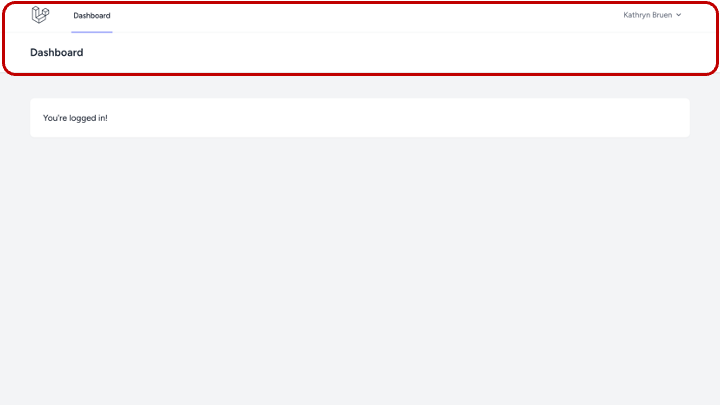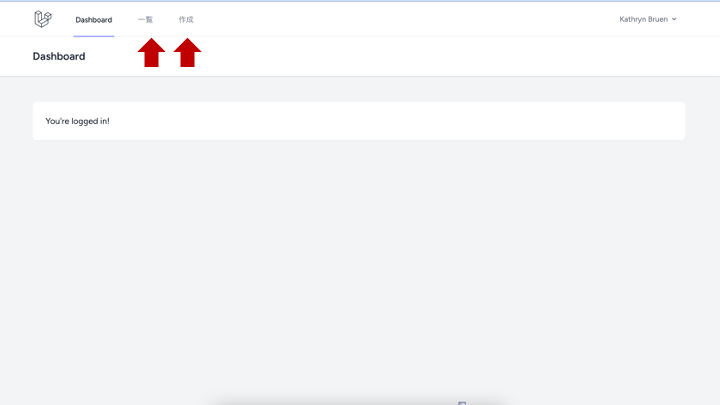実際にブラウザに表示する画面を記載するviewファイルは、( ).blade.phpという形で作成します。これはbladeテンプレートと呼ばれる形式です。
viewファイルはresource -> viewsの中に保存する。この中にファイルが多くなる場合はフォルダを作って管理するといいでしょう。
bladeテンプレートの特徴は、共通パーツと個別パーツを組み合わせて画面を構成していくところにあります。例えば「アプリケーション全体を通して表示されるナビゲーションバー」や「エラー画面」などは、共通パーツとして作成し決められた場所に保存しておきます。これらのことを「コンポーネント」と言います。今回はコンポーネントの例として、(ⅰ)ナビゲーションバー(ⅱ)エラー画面 の2つを作成していきます。
Case.1 ナビゲーションバーを作成する。
実はナビゲーションバーはすでにLaravelが用意してくれています。今回はそれに「一覧」「作成」の2つのリンクを付けてみます。まずは、resource -> veiws -> layouts にデフォルトで用意されている navigation.blade.phpを見てみましょう。
<nav x-data="{ open: false }" class="bg-white border-b border-gray-100">
<!-- Primary Navigation Menu -->
<div class="max-w-7xl mx-auto px-4 sm:px-6 lg:px-8">
<div class="flex justify-between h-16">
<div class="flex">
<!-- Logo -->
<div class="shrink-0 flex items-center">
<a href="{{ route('dashboard') }}">
<x-application-logo class="block h-9 w-auto fill-current text-gray-800" />
</a>
</div>
<!-- Navigation Links -->
<div class="hidden space-x-8 sm:-my-px sm:ml-10 sm:flex">
<x-nav-link :href="route('dashboard')" :active="request()->routeIs('dashboard')">
{{ __('Dashboard') }}
</x-nav-link>
</div>
</div>
<!-- Settings Dropdown -->
<div class="hidden sm:flex sm:items-center sm:ml-6">
<x-dropdown align="right" width="48">
<x-slot name="trigger">
<button class="inline-flex items-center px-3 py-2 border border-transparent text-sm leading-4 font-medium rounded-md text-gray-500 bg-white hover:text-gray-700 focus:outline-none transition ease-in-out duration-150">
<div>{{ Auth::user()->name }}</div>
<div class="ml-1">
<svg class="fill-current h-4 w-4" xmlns="http://www.w3.org/2000/svg" viewBox="0 0 20 20">
<path fill-rule="evenodd" d="M5.293 7.293a1 1 0 011.414 0L10 10.586l3.293-3.293a1 1 0 111.414 1.414l-4 4a1 1 0 01-1.414 0l-4-4a1 1 0 010-1.414z" clip-rule="evenodd" />
</svg>
</div>
</button>
</x-slot>
<x-slot name="content">
<x-dropdown-link :href="route('profile.edit')">
{{ __('Profile') }}
</x-dropdown-link>
<!-- Authentication -->
<form method="POST" action="{{ route('logout') }}">
@csrf
<x-dropdown-link :href="route('logout')"
onclick="event.preventDefault();
this.closest('form').submit();">
{{ __('Log Out') }}
</x-dropdown-link>
</form>
</x-slot>
</x-dropdown>
</div>
<!-- Hamburger -->
<div class="-mr-2 flex items-center sm:hidden">
<button @click="open = ! open" class="inline-flex items-center justify-center p-2 rounded-md text-gray-400 hover:text-gray-500 hover:bg-gray-100 focus:outline-none focus:bg-gray-100 focus:text-gray-500 transition duration-150 ease-in-out">
<svg class="h-6 w-6" stroke="currentColor" fill="none" viewBox="0 0 24 24">
<path :class="{'hidden': open, 'inline-flex': ! open }" class="inline-flex" stroke-linecap="round" stroke-linejoin="round" stroke-width="2" d="M4 6h16M4 12h16M4 18h16" />
<path :class="{'hidden': ! open, 'inline-flex': open }" class="hidden" stroke-linecap="round" stroke-linejoin="round" stroke-width="2" d="M6 18L18 6M6 6l12 12" />
</svg>
</button>
</div>
</div>
</div>
<!-- Responsive Navigation Menu -->
<div :class="{'block': open, 'hidden': ! open}" class="hidden sm:hidden">
<div class="pt-2 pb-3 space-y-1">
<x-responsive-nav-link :href="route('dashboard')" :active="request()->routeIs('dashboard')">
{{ __('Dashboard') }}
</x-responsive-nav-link>
</div>
<!-- Responsive Settings Options -->
<div class="pt-4 pb-1 border-t border-gray-200">
<div class="px-4">
<div class="font-medium text-base text-gray-800">{{ Auth::user()->name }}</div>
<div class="font-medium text-sm text-gray-500">{{ Auth::user()->email }}</div>
</div>
<div class="mt-3 space-y-1">
<x-responsive-nav-link :href="route('profile.edit')">
{{ __('Profile') }}
</x-responsive-nav-link>
<!-- Authentication -->
<form method="POST" action="{{ route('logout') }}">
@csrf
<x-responsive-nav-link :href="route('logout')"
onclick="event.preventDefault();
this.closest('form').submit();">
{{ __('Log Out') }}
</x-responsive-nav-link>
</form>
</div>
</div>
</div>
</nav>
何となくどこに何が書いてあるか分かりますね。(レスポンシブ対応もある!)
これが画面上部の
この部分になります。ここに「一覧」👇
<div class="hidden space-x-8 sm:-my-px sm:ml-10 sm:flex">
<x-nav-link :href="route('tweet.index')" :active="request()->routeIs('tweet.index')">
{{ __('「一覧」') }}
</x-nav-link>
</div>
と「作成」👇
<div class="hidden space-x-8 sm:-my-px sm:ml-10 sm:flex">
<x-nav-link :href="route('tweet.create')" :active="request()->routeIs('tweet.create')">
{{ __('作成') }}
</x-nav-link>
</div>
を追加します。場所を確認してください。
<nav x-data="{ open: false }" class="bg-white dark:bg-gray-800 border-b border-gray-100 dark:border-gray-700">
<!-- Primary Navigation Menu -->
<div class="max-w-7xl mx-auto px-4 sm:px-6 lg:px-8">
<div class="flex justify-between h-16">
<div class="flex">
<!-- Logo -->
<div class="shrink-0 flex items-center">
<a href="{{ route('dashboard') }}">
<x-application-logo class="block h-9 w-auto fill-current text-gray-800 dark:text-gray-200" />
</a>
</div>
<!-- Navigation Links -->
<div class="hidden space-x-8 sm:-my-px sm:ml-10 sm:flex">
<x-nav-link :href="route('dashboard')" :active="request()->routeIs('dashboard')">
{{ __('Dashboard') }}
</x-nav-link>
</div>
<!-- 🔽 一覧ページへのリンクを追加 -->
<div class="hidden space-x-8 sm:-my-px sm:ml-10 sm:flex">
<x-nav-link :href="route('tweet.index')" :active="request()->routeIs('tweet.index')">
{{ __('一覧') }}
</x-nav-link>
</div>
<!-- 🔽 作成ページへのリンクを追加 -->
<div class="hidden space-x-8 sm:-my-px sm:ml-10 sm:flex">
<x-nav-link :href="route('tweet.create')" :active="request()->routeIs('tweet.create')">
{{ __('作成') }}
</x-nav-link>
</div>
</div>
<!-- Settings Dropdown -->
<div class="hidden sm:flex sm:items-center sm:ml-6">
<x-dropdown align="right" width="48">
<x-slot name="trigger">
<button class="inline-flex items-center px-3 py-2 border border-transparent text-sm leading-4 font-medium rounded-md text-gray-500 dark:text-gray-400 bg-white dark:bg-gray-800 hover:text-gray-700 dark:hover:text-gray-300 focus:outline-none transition ease-in-out duration-150">
<div>{{ Auth::user()->name }}</div>
<div class="ml-1">
<svg class="fill-current h-4 w-4" xmlns="http://www.w3.org/2000/svg" viewBox="0 0 20 20">
<path fill-rule="evenodd" d="M5.293 7.293a1 1 0 011.414 0L10 10.586l3.293-3.293a1 1 0 111.414 1.414l-4 4a1 1 0 01-1.414 0l-4-4a1 1 0 010-1.414z" clip-rule="evenodd" />
</svg>
</div>
</button>
</x-slot>
<x-slot name="content">
<x-dropdown-link :href="route('profile.edit')">
{{ __('Profile') }}
</x-dropdown-link>
<!-- Authentication -->
<form method="POST" action="{{ route('logout') }}">
@csrf
<x-dropdown-link :href="route('logout')" onclick="event.preventDefault();
this.closest('form').submit();">
{{ __('Log Out') }}
</x-dropdown-link>
</form>
</x-slot>
</x-dropdown>
</div>
<!-- Hamburger -->
<div class="-mr-2 flex items-center sm:hidden">
<button @click="open = ! open" class="inline-flex items-center justify-center p-2 rounded-md text-gray-400 dark:text-gray-500 hover:text-gray-500 dark:hover:text-gray-400 hover:bg-gray-100 dark:hover:bg-gray-900 focus:outline-none focus:bg-gray-100 dark:focus:bg-gray-900 focus:text-gray-500 dark:focus:text-gray-400 transition duration-150 ease-in-out">
<svg class="h-6 w-6" stroke="currentColor" fill="none" viewBox="0 0 24 24">
<path :class="{'hidden': open, 'inline-flex': ! open }" class="inline-flex" stroke-linecap="round" stroke-linejoin="round" stroke-width="2" d="M4 6h16M4 12h16M4 18h16" />
<path :class="{'hidden': ! open, 'inline-flex': open }" class="hidden" stroke-linecap="round" stroke-linejoin="round" stroke-width="2" d="M6 18L18 6M6 6l12 12" />
</svg>
</button>
</div>
</div>
</div>
<!-- Responsive Navigation Menu -->
<div :class="{'block': open, 'hidden': ! open}" class="hidden sm:hidden">
<div class="pt-2 pb-3 space-y-1">
<x-responsive-nav-link :href="route('dashboard')" :active="request()->routeIs('dashboard')">
{{ __('Dashboard') }}
</x-responsive-nav-link>
</div>
<!-- 🔽 一覧ページへのリンクを追加 -->
<div class="pt-2 pb-3 space-y-1">
<x-responsive-nav-link :href="route('tweet.index')" :active="request()->routeIs('tweet.index')">
{{ __('一覧') }}
</x-responsive-nav-link>
</div>
<!-- 🔽 作成ページへのリンクを追加 -->
<div class="pt-2 pb-3 space-y-1">
<x-responsive-nav-link :href="route('tweet.create')" :active="request()->routeIs('tweet.create')">
{{ __('作成') }}
</x-responsive-nav-link>
</div>
<!-- Responsive Settings Options -->
<div class="pt-4 pb-1 border-t border-gray-200 dark:border-gray-600">
<div class="px-4">
<div class="font-medium text-base text-gray-800 dark:text-gray-200">{{ Auth::user()->name }}</div>
<div class="font-medium text-sm text-gray-500">{{ Auth::user()->email }}</div>
</div>
<div class="mt-3 space-y-1">
<x-responsive-nav-link :href="route('profile.edit')">
{{ __('Profile') }}
</x-responsive-nav-link>
<!-- Authentication -->
<form method="POST" action="{{ route('logout') }}">
@csrf
<x-responsive-nav-link :href="route('logout')" onclick="event.preventDefault();
this.closest('form').submit();">
{{ __('Log Out') }}
</x-responsive-nav-link>
</form>
</div>
</div>
</div>
</nav>
忘れずにレスポンシブの方にもリンクを入れておきます。これで下のような感じに追加されました。
ちなみに、この後のルーティングは書いていますが、処理はまだのため、ここをクリックしても空白のページに飛ぶだけです。
Case.2 エラー画面を作成する。
先ほどはlaravelが用意してくれていたコンポーネントを利用して「ナビゲーションバー」の調整を行いましたが、今度は一から自分で作るコンポーネントの例として、エラー画面を作成していきます。今回はresources -> viewsの中に「common」というディレクトリを作り、その中に ファイルを置くこととします。
入力値が不正であったりする場合に表示されるエラー画面も複数の場面で必要となるため、共通のコンポーネントとして用意しておいた方が便利です。まずはターミナルでディレクトリを作成します。
$ mkdir resources/views/common
このとき、自分の作成しているProjectのフォルダ内で実行するのを忘れないようにしましょう。
※VScodeでターミナルを開いていれば自動的にこのフォルダ内となっています。
この中にerrors.blade.phpというファイルを作成します。
resources -> views -> common -> errors.blade.php
@if (count($errors) > 0)
<div>
<div class="font-medium text-red-600">
{{ __('Whoops! Something went wrong.') }}
</div>
<ul class="mt-3 list-disc list-inside text-sm text-red-600">
@foreach ($errors->all() as $error)
<li>{{ $error }}</li>
@endforeach
</ul>
</div>
@endif
これでOKです。
次の記事

